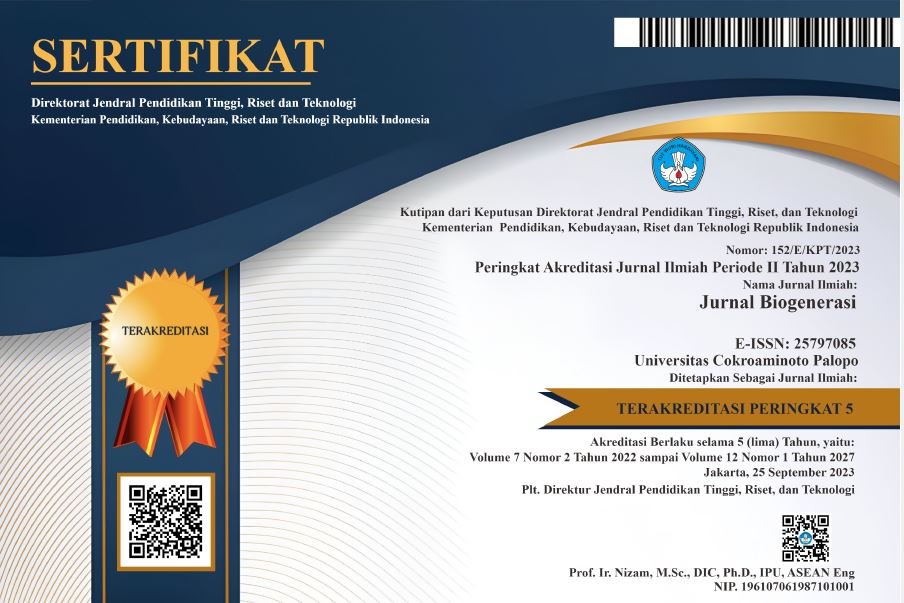ANALISIS KETERAMPILAN BERPIKIR KRITIS PESERTA DIDIK FASE F PADA MATERI SIRKULASI DARAH DI SMA NEGERI 1 LINGGO SARI BAGANTI
DOI:
https://doi.org/10.30605/biogenerasi.v10i2.5361Keywords:
Critical Thinking Skills, Blood Circulation, DescriptiveAbstract
The aim of this research is to determine the level of critical thinking skills of phase F students at SMA Negeri 1 Linggo Sari Baganti regarding Blood Circulation material. This research is descriptive research, with the population being phase F students at SMA Negeri 1 Linggo Sari Baganti. Samples were taken using a purposive random sampling technique, with a total sample of 40 people. The data used is primary data obtained through test instruments in the form of critical thinking skills questions about Blood Circulation material which are valid and reliable. Based on the research results, it was found that the level of students' critical thinking skills in answering blood circulation material questions in each aspect: in the interpretation aspect was in the very low category, in the analysis, evaluation, inference, explanation and self-regulation aspects in the low category. From these results, it was obtained that the average value of the critical thinking skill level of phase F students at SMA Negeri 1 Linggo Sari Baganti was 49.33% in the low category. Therefore, it is necessary to improve the critical thinking skills of phase F students at SMA Negeri 1 Linggo Sari Baganti in the low category.
Downloads
References
Arizona. N. 2019. Analisis Keterampilan Berpikir Kritis Peserta Didik Kelas VII SMP Negeri 12 Padang Pada Pembelajaran IPA. Skripsi. UNP: Padang.
Asriandi A., Kattya N., 2020. Kompetensi generasi z dalam menghadapi era revolusi industri 4.0 (studi kasus perguruan tinggi di makassar). Journal of Mangement and Business. ISSN (Print) : 2598-831X, ISSN (Online) 2598- 8301.
Deni S., Tedi P., Qiqi Y. 2022. Konsep Implementasi Kurikulum Prototype. Jurnal Basicedu. Bandung. Vol 6 No 4 Tahun 2022.
Facione, P.A. 2013. Critical thinking what it is and Why it Coun Millbrae, California .
Ferdyan, R., & Arsih, F. 2021. Analisis Kemampuan Literasi Sains Dan Keterampilan Berpikir Kritis Siswa Terhadap Covid-19 Berdasarkan Materi Yang Relevan Dalam Pembelajaran Biologi. Bio-Lectura : Jurnal Pendidikan Biologi, 8(2), 12–24.
Hayudiyani., Muchamad, A., & Medika, R. 2017. Identifikasi keterampilan berpikir kritis siswa kelas X TKJ ditinjau dari keterampilan awal dan jenis kelamin siswa di SMKN 1 Kamal. Jurnal Ilmiah Edutic, 4(1), 20-27.
Koasih, E. 2014. Strategi Belajar dan Pembelajaran. Bandung: Yrama Widya.
Maslakhatunni’mah D., Linda Budi & Desi Nuzul. 2019. Analisis Kemampuan Berfikir Kritis Pada Mata Pelajaran Ipa Siswa Kelas VII SMP. Seminar Nasional Pendidikan Sains. STKIP Modern Ngawi.
Mira Azizah, dkk, Analisis Keterampilan Berpikir Kritis Siswa Sekolah Dasar Pada Pembelajaran Matematika Kurikulum 2013. Jurnal penelitian pendidikan. Vol 35, No 1, 2018, hal 65.
Osman, K., Hiong, L. C., & Vebrianto, R. 2013. 21st century biology: anterdiciplinary approach of biology, technology, engineering, and mathematics education. Procedia Social and Behavior Science, 102, 188- 194.
Pujiono, Setyawan. 2012. Berpikir Kritis dalam Literasi membaca dan menulis untuk memperkuat jati diri bangsa. 778-783. UNSOED: Prosiding Bahasa dan Sastra Indonesia.
Retnawati H. 2016. Analisis Kuantitatif Instrumen Penelitian. Parama Publishing.
Ruggerio, V. R. 2012. Beyond Feelings: A Guide to Critical Thinking. New York: McGraw-Hill.
Scriven, M., & Paul, R. 1987. Critical Thinking as Defined by the National Council for Excellence in Critical Thinking.
Sugiyono. 2018. Metode Penelitian Kuantitatif, Kualitatif dan R&D. Bandung: Afabeta.
Susilowati, Sajidan, & Murni. 2017. Analisis Keterampilan Berpikir Kritis Siswa Madrasah Aliyah Negeri di Kabupaten Magetan. Prosiding Seminar Nasional Pendidikan Sains (SNPS)
Siyoto, Sandu dan Ali Sodik. 2015. Dasar Metodologi Penelitian. Yogayakrta: Literasi Media Publishing.
Downloads
Published
How to Cite
Issue
Section
License
In submitting the manuscript to the journal, the authors certify that:
- They are authorized by their co-authors to enter into these arrangements.
- The work described has not been formally published before, except in the form of an abstract or as part of a published lecture, review, thesis, or overlay journal.
- That it is not under consideration for publication elsewhere,
- That its publication has been approved by all the author(s) and by the responsible authorities – tacitly or explicitly – of the institutes where the work has been carried out.
- They secure the right to reproduce any material that has already been published or copyrighted elsewhere.
- They agree to the following license and copyright agreement.
License and Copyright Agreement
Authors who publish with this journal agree to the following terms:
- Authors retain copyright and grant the journal right of first publication with the work simultaneously licensed under Creative Commons Attribution License (CC BY 4.0) that allows others to share the work with an acknowledgment of the work's authorship and initial publication in this journal.
- Authors are able to enter into separate, additional contractual arrangements for the non-exclusive distribution of the journal's published version of the work (e.g., post it to an institutional repository or publish it in a book), with an acknowledgment of its initial publication in this journal.
- Authors are permitted and encouraged to post their work online (e.g., in institutional repositories or on their website) prior to and during the submission process, as it can lead to productive exchanges, as well as earlier and greater citation of published work.


.png)

